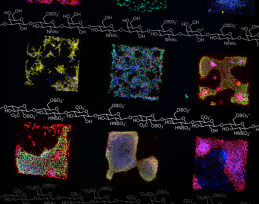Controlling cells’ environments: a step toward building much-needed tissues and organs
August 30, 2011

Cells growing on surfaces with different materials on them are shown in colored squares. The chemical structures represent the molecules on the cells that bind to the surfaces (credit: Laura L. Kiessling)
University of Wisconsin-Madison researchers have found reproducible methods to control how pluripotent human embryonic stem cells differentiate (grow into specific heart cells, brain cells, and other kinds of cells).
Past approaches to growing stem cells have involved adding growth-regulating substances to cultures of stem cells growing in the laboratory. These conditions left scientists guessing about exactly what wound up in the stem cells.
The researchers found that chemically defined surfaces can exert control over signaling pathways. “Signaling” is how molecules talk to one another and get things done inside a cell. They used a signaling substance, “transforming growth factor-beta” (TGF-beta) to control cell growth and differentiation.
The researchers said this is an advance toward using stem cells in regenerative medicine to grow organs from scratch for transplants and tissues for treating diseases.
Their research is being presented at the 242nd National Meeting & Exposition of the American Chemical Society (ACS).